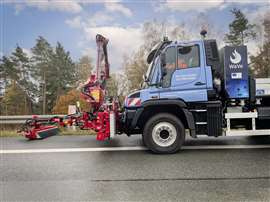Read this article in French German Italian Portuguese Spanish
Mercedes-Benz hydrogen-powered trucks hit the road
21 December 2023
Daimler Truck announced two separate field trials of hydrogen-powered technology in Mercedes-Benz vehicles. The first will see the GenH2 fuel cell trucks moving into customer field trials, while the second entails research testing of a Unimog prototype utilizing a hydrogen combustion engine.
 The Mercedes-Benz GenH2 fuel cell trucks have reached an advanced development stage for deployment in first customer fleets. (Photo: Mercedes-Benz/Daimler Truck)
The Mercedes-Benz GenH2 fuel cell trucks have reached an advanced development stage for deployment in first customer fleets. (Photo: Mercedes-Benz/Daimler Truck)
Starting in mid-2024, the Mercedes-Benz GenH2 trucks will be deployed by Amazon, Air Products, INEOS, Holcim and Wiedmann & Winz to gain initial experience in long-distance transport with the fuel cell vehicles, Daimler Trucks stated. The five semi-trailer tractors will be deployed in different long-haul applications on specific routes in Germany. During these first customer trials, the vehicles will remain under the direct supervision and responsibility of Mercedes-Benz Trucks. They will be refueled at designated public liquid hydrogen filling stations (sLH2) in Wörth am Rhein and in the Duisburg area.
The GenH2 trucks are based on the characteristics of the conventional Actros long-haul truck in terms of payload, range and performance, the company said. A cellcentric fuel cell system rated 300 kW (2 x150 kW) and a battery providing an additional 400 kW temporarily enable the test vehicles’ 25-ton payload capacity and 40-ton gross combination weight rating. Two 44-kg liquid hydrogen tanks (88 kg total) will allow for long-range transport.
“With this first customer fleet, our fuel cell trucks are now being tested in real customer operation. A win-win situation for both sides: our customers get to know fuel-cell technology in daily real-life operation and our engineering team gets to better understand customer needs and relevant use cases, taking them into account for series development,” said Andreas Gorbach, Member of the Board of Management of Daimler Truck AG, responsible for Truck Technology.
 The Unimog implement carrier prototype utilizes a specially converted natural gas engine. (Photo: Mercedes-Benz/Daimler Truck)
The Unimog implement carrier prototype utilizes a specially converted natural gas engine. (Photo: Mercedes-Benz/Daimler Truck)
H2 ICE put to real-world test
Mercedes-Benz Special Trucks has placed a Unimog implement carrier prototype equipped with a hydrogen combustion engine in a real-world application, Daimler Truck reported. The test was part of research into the conditions under which hydrogen combustion can be implemented as a supplement to battery-electric and fuel cell-based drives.
The test vehicle is based on the Unimog U 430 implement carrier. A specially converted natural gas engine delivering roughly 290 hp (1,000 Nm), tanks, safety and monitoring systems and measurement technology were installed for the alternative hydrogen technology drive. The wheelbase and platform length were configured so that the four TÜV-certified, 700-bar high-pressure hydrogen tanks can be installed behind the cab. The tanks hold a total of around 14 kg of gaseous hydrogen and are combined into two double tanks, each of which is operated independently via a tank control unit.
 The prototype was equipped with a front mower featuring two mowing heads in order to gain further insights in work mode. (Photo: Mercedes-Benz/Daimler Truck)
The prototype was equipped with a front mower featuring two mowing heads in order to gain further insights in work mode. (Photo: Mercedes-Benz/Daimler Truck)
The test took place on a decommissioned section of highway between Bayreuth and Bamberg, with the prototype equipped with a front mower featuring two mowing heads in order to gain further insights in work mode. Engineers collected measurement data when mowing the verge, accelerating and refueling at a public gas station for use in further vehicle development.
The development of the test vehicle with a hydrogen combustion engine is taking place within the framework of the publicly funded “WaVe” project, which is being jointly implemented by 18 partners working together on the hydrogen combustion engine drive concept. Practical testing at low temperatures and in varied topography is an important step in the ongoing development.
After the first successful practical application, the development team will use the remaining six months of the project to make further adjustments and refinements. In a next development stage, the engineers aim to increase the tank volume to be able to cover a full working day.
POWER SOURCING GUIDE
The trusted reference and buyer’s guide for 83 years
The original “desktop search engine,” guiding nearly 10,000 users in more than 90 countries it is the primary reference for specifications and details on all the components that go into engine systems.
Visit Now
STAY CONNECTED




Receive the information you need when you need it through our world-leading magazines, newsletters and daily briefings.
CONNECT WITH THE TEAM










